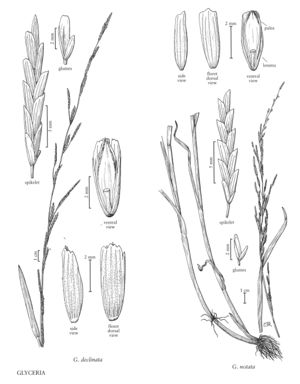Glyceria declinata
Plants usually perennial, rarely annual. Culms (10) 20-92 cm tall, 1.5-2.5 mm thick, ascending to erect from a decumbent, branching base. Sheaths glabrous, keeled; ligules 4-9 mm; blades (2) 3-12 cm long, 4-8 mm wide, adaxial surfaces not papillose, apices abruptly acute. Panicles 6-30 cm long, 1-2.5 cm wide; branches 1.5-9.5 cm, ascending, with 1-5 spikelets; pedicels 1-2.5 mm. Spikelets 11-24 mm long, 1.3-3 mm wide, cylindrical and terete, except slightly laterally compressed at anthesis, rectangular in side view, with 8-15 florets. Glumes oval; lower glumes 1.4-3.5 mm; upper glumes 2.5-4.9 mm; rachilla internodes 1.2-1.8 mm; lemmas (3.5) 4-6 mm, 7-veined, veins and intercostal regions scabridulous, prickles about 0.05 mm, midveins extending to within 0.1 mm of the apical margins, apices acute, with a well-developed lobe on one or both sides opposite the lateral-veins, entire to crenulate between the lateral lobes; paleas exceeding the lemmas by 0.2-1 (1.5) mm, keels winged, apices bifid, teeth 0.3-0.5 mm; anthers 0.5-1.4 mm, usually purple. Caryopses 1.8-2.5 mm. 2n = 20.
Distribution
Tex., La., B.C., N.C., N.Y., Nev.
Discussion
Glyceria declinata is a European species that is established on the western seaboard of North America from southern British Columbia to southern California, and in northeastern Nevada, Arizona, the lower portion of the Mississippi valley, and on Long Island, New York. In Europe, it grows in low-calcium, acidic soils and tolerates drier conditions than other European species of Glyceria (Conert 1992). In Denmark, it tends to grow in areas that are highly trampled (Niels Jacobsen and Signe Frederiksen, pers. comm.). It is invading vernal pools in California.
In western North America, G. declinata has been confused with G. xoccidentalis. The most reliable distinguishing characteristics are the lateral lemma lobes of G. declinata and its rather short, straight panicle branches. The two species also differ in their ploidy level, G. declinata being diploid and G. xoccidentalis tetraploid (Church 1949). This is reflected in the length of their guard cells, those of G. declinata being 0.2-0.3 um and those of G. xoccidentalis being 0.4-0.5 um.
S.F. Hrusa found plants (Hrusa 13681, 15858, 16267; specimens in CDA) that have an annual growth habit. Apart from this, they fit within the circumscrip¬tion of G. declinata, except that two of the three specimens have narrower (2-3 mm) leaves than normal; they were also collected relatively early in the season. For now, it seems best to include the plants in G. declinata pending a better understanding of their relationship to perennial members of the species.
Selected References
None.
Lower Taxa
"decumbent" is not a number.
